Abu Dhabi, UAE— In order to speed up the energy transition there must be a fast increase in the production of green hydrogen, according to a joint report by the International Renewable Energy Agency (IRENA) and World Trade Organisation (WTO).
The report published on December 9 provides insights into global hydrogen trade and related policies for scaling up production.
Hydrogen produced exclusively from renewable power – known as green hydrogen – is widely recognised as a key pillar in replacing fossil fuels and decarbonising sectors that cannot easily be electrified, such as some industrial processes, shipping and aviation.
The energy transition will require a fast increase in the production of green hydrogen. IRENA estimates that hydrogen and its derivatives would meet 14% of global final energy consumption in 2050 in a scenario in which rising global temperatures resulting from emissions are limited to not more than 1.5°C.
At present, most global hydrogen production – around 95 megatons per year – is derived from fossil fuels, contributing substantially to climate change, rather than serving as a vehicle for decarbonization. The report stresses the urgency of transforming the hydrogen landscape, with existing uses transitioning to a clean hydrogen supply and overall hydrogen production expanding more than five-fold by 2050. This expansion will require an unprecedented scale-up of renewable generation capacity and electrolyser capacity.
“In a net-zero world, the current landscape of hydrogen production and consumption needs to change dramatically,” stated Roland Roesch, Director IRENA’s Innovation and Technology Centre. “Global trade of green hydrogen and its derivatives will be crucial to link low production cost and high demand locations,” he added.
The report emphasises that green hydrogen production expansion will require the development of new supply chains. This will have implications in terms of international trade of renewable hydrogen itself or commodities produced with it, as well as the trade of the necessary equipment and services along the value chain.
The publication highlights how lowering tariffs on key products, building reliable infrastructure, realigning domestic support programmes and developing green government procurement can foster the development of green hydrogen supply chains and the transition to a low-carbon economy. International trade could also play a significant role in matching supply and demand for green hydrogen, as the potential for domestic production in some economies might not be enough to satisfy domestic demand.
“Open, predictable and coherent trade will be key to fostering green hydrogen value chains,” said Aik Hoe Lim, the Director of the WTO Trade and Environment Division, at the publication’s launch event. Considering specifically the importance of standards and verification procedures for building a sustainable hydrogen market, he added: “WTO disciplines can provide useful guidance on how to develop truly international standards, aligned national regulations and compatible verification procedures.”
The publication also addresses the challenges and opportunities for developing economies offered by green hydrogen and its derivatives, such as green methanol and green ammonia. It underscores the importance of international cooperation and the need to align regulatory frameworks to encourage technology development, enhanced transparency and market growth.








